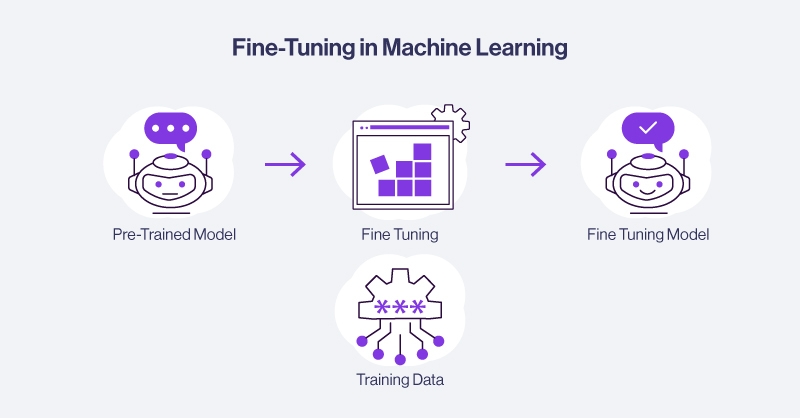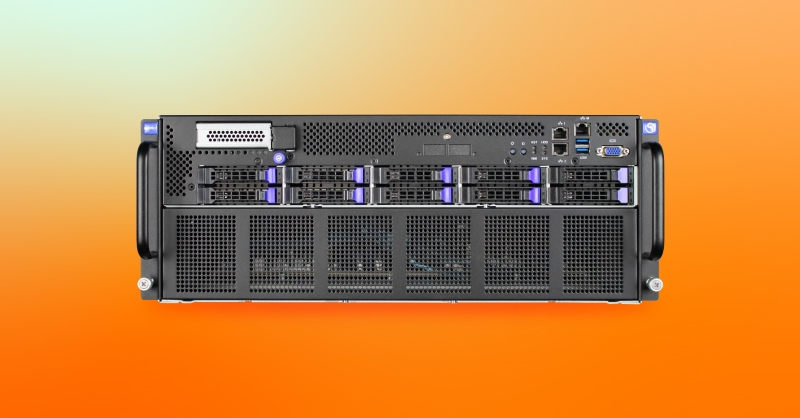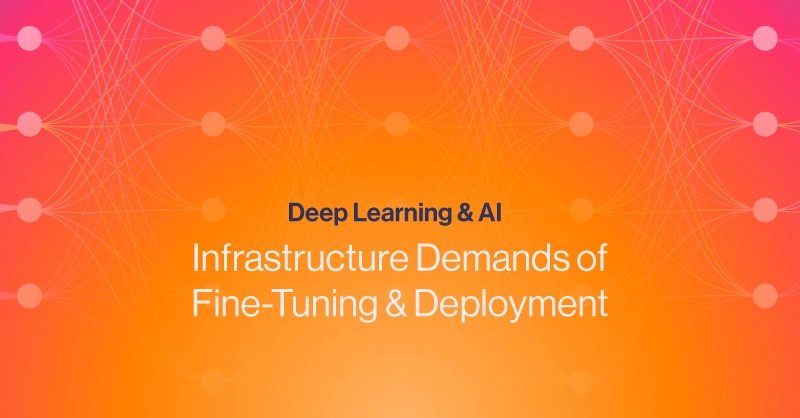Introduction
While organizations invest heavily in AI model training infrastructure, they often overlook the critical post-training demands that dominate real-world AI deployments. Enterprise businesses rarely train models from scratch and continually struggle with the hidden costs of deployment.
The painful truth: after initial training comes the real infrastructure challenge. Fine-tuning, inference, versioning, and continuous evaluation introduce substantial operational demands that consistently exceed budget forecasts and strain IT resources.
To deploy AI at scale, we need to understand these overlooked post-training requirements and their significant impact on GPU utilization, computing resources, and total cost of ownership.
Fine-Tuning: The Overlooked Cost Center in AI Workflows
Fine-tuning a generic AI model transforms it into a specialized tool for your business needs but comes with hidden costs that many organizations underestimate. Despite being less intensive than training from scratch, fine-tuning is still a computational hurdle.
- Hardware: GPUs with ample fast VRAM, fast interconnect, and high-performance capabilities all lend themselves well to fine-tuning workloads.
- Repetitive costs: Fine-tuning happens repeatedly across customers, regions, and product lines.
- Dedicated resources: Most enterprises need permanent GPU allocations, not just spot instances
Fine-tuning isn't a one-time expense; it's an ongoing operational cost. With foundation models growing to billions of parameters, these costs escalate quickly. Even optimization techniques like LoRA and PEFT still demand substantial resources. A McKinsey report estimates fine-tuning a single chatbot can cost tens to hundreds of millions of dollars.

Model Serving: Inference at Scale Is Not Lightweight
After fine-tuning, your model requires robust deployment infrastructure, not just simple API endpoints. Enterprise AI applications demand high performance under intense pressure:
- High availability (99.99% uptime) - because downtime means lost revenue
- Fast response times (<100ms latency) - because users abandon slow services
- Elastic scaling - from dozens to millions of users without breaking
- Cost optimization - idle GPUs drain budgets rapidly
Your production AI stack requires:
| Component | Purpose |
| Model Server | NVIDIA Triton or TensorFlow Serving for request handling |
| Acceleration | ONNX Runtime or TensorRT for performance optimization |
| Load Balancing | Intelligent request distribution |
| Autoscaling | Dynamic resource allocation |
| Caching | Performance boost for common queries |
| Failover | Business continuity protection |
The GPU Utilization Challenge
Inference infrastructure costs frequently exceed training budgets due to 24/7 GPU utilization and high-availability requirements.
Unlike training, inference traffic is unpredictable. This creates a fundamental tension between performance and cost that's difficult to solve:
- GPU scaling lags behind demand spikes by crucial seconds or minutes
- Cold starts (15-30 seconds) create unacceptable user experiences
- Overprovisioning wastes thousands in GPU costs
Modern accelerators like vLLM and TGI help but require specialized expertise to implement effectively.
Model Operations: The Hidden Complexity
Most AI project failures stem from inadequate deployment infrastructure rather than model quality issues. AI systems require continuous updates to remain competitive. This demands infrastructure for:
- Multi-model deployment for different customer segments or capabilities
- Fast rollback when models underperform
- Controlled experimentation to validate improvements
These capabilities require additional components:
- Model registries for version tracking and compliance
- Enterprise-grade storage for model artifacts and test cases
- Advanced orchestration for traffic management across model versions
Real-time monitoring becomes essential to catch issues before they affect users. Without proper metrics for latency, accuracy and drift, production AI becomes a black box of uncertainty.
Infrastructure Implications: TCO Beyond Training
Organizations that plan infrastructure solely around training tend to underestimate their long-term operational costs. In practice, post-training activities often account for a significant portion of AI-related expenses, especially when scaled across multiple applications and regions.
The following factors contribute heavily to ongoing Total Cost of Ownership (TCO):
- Persistent GPU utilization for inference and scheduled fine-tuning
- Storage costs for maintaining multiple model versions and checkpoints
- Networking and orchestration complexity as workloads grow more dynamic
- Monitoring and observability tools to ensure operational health and compliance
This shift from capital expenditure (e.g., training clusters) to operational expenditure (e.g., 24/7 inference and model governance) is critical to understand when budgeting for AI initiatives.
Key Insight: AI infrastructure is not a one-time investment. It requires ongoing resource allocation, just like any other business-critical system.
Best Practices for Managing the Full Model Lifecycle
Test and Optimize Models for Continuous Development
- Optimize Models for Inference: Utilize quantization and model distillation to reduce serving costs. Consider deploying smaller model variants for non-critical tasks or edge environments. Be mindful of performance: more quantized models are less knowledgeable and more prone to hallucinating.
- Build Modular, Resilient Deployment Architectures: Containerize models and inference engines using Docker. Use orchestration tools like Kubernetes, Kubeflow, or Ray Serve for scalable, fault-tolerant deployment.
- Design for A/B Testing Deployments: Implement traffic-splitting and monitoring strategies to evaluate model performance safely before full rollout. Use progressive rollout mechanisms to minimize impact in case of regressions.
Address Infrastructure Needs with Scheduling and Monitoring
- Implement Smart Scheduling for Fine-Tuning: Run resource-intensive fine-tuning jobs during off-peak hours to minimize competition for shared resources. Use priority-based schedulers or job queues in Kubernetes to manage workloads intelligently. Many companies will offload some computational resources to run overnight to tackle fine-tuning workloads.
- Leverage Model Registries and CI/CD Pipelines: Use tools like MLflow, Weights & Biases, or SageMaker to track experiments and model versions. Integrate model deployment into CI/CD pipelines using Argo, KServe, or Seldon Core.
- Monitor Infrastructure Usage Proactively: Deploy observability tools such as Prometheus + Grafana, Datadog, or KubeCost. Track GPU utilization, memory usage, latency metrics, and request throughput to identify bottlenecks early.
Choose Optimal Hardware for Fine-Tuning and Inference
- Select Specialized Hardware Solutions: Balance performance, scalability, and cost-effectiveness across your AI lifecycle. Modern GPU architectures offer significant advantages for both fine-tuning and inference workloads. Read about our recommended best GPUs for AI. Here are popular options:
- NVIDIA H200 NVL: Ideal for large-scale fine-tuning operations with its massive 141GB HBM3e memory, PCIe Gen5 support, and enhanced transformer performance. The NVLink technology enables multiple GPUs to function as a unified memory pool, critical for handling the largest foundation models.
- NVIDIA RTX PRO 6000 Blackwell: Offers an excellent balance for mixed workloads with 96GB GDDR7 memory and optimized inference performance. Its professional-grade reliability makes it suitable for 24/7 production environments where consistent performance is critical.
- Consider your Deployment Scenario: Different workloads yield different solutions, and the cost of your hardware can be a limiting factor. Knowing what hardware can address your needs can help either justify or steer you to the right solution.
- For fine-tuning dominant workloads: Prioritize memory capacity and bandwidth with H200-based systems
- For inference-heavy deployments: Focus on throughput-optimized solutions with efficient scaling capabilities. RTX PRO 6000 Blackwell has plenty VRAM and high throughput for handling inference tasks.
- For edge AI deployments: Consider power-efficient options that maintain acceptable latency. Consider other RTX PRO Blackwell GPUs that fit your power budget.
- Work with Experienced Solution Integrators: Our engineers at SabrePC ensure you get a tailored hardware configuration that addresses your specific AI workload profile.

Companies Must Familiarize Themselves with the AI Development Lifecycle
AI is beyond the research to being adopted into critical business function and driving competitive advantage. Despite this, companies continue to underinvest in the infrastructure needed for production environments.
The painful truth: organizations struggle with deploying models because they focus too much on training while neglecting fine-tuning, inference, versioning, and testing—all of which require significant infrastructure investment beyond the training workload. This oversight leads to:
- Unexpected operational costs
- Performance bottlenecks
- Reliability issues
- Delayed time-to-market
Companies that build robust infrastructure for the entire AI lifecycle gain sustainable advantages such as faster deployment, optimized costs, and consistently reliable model performance.
Success in AI doesn't come from better models alone—it requires better infrastructure. If you’re looking to upgrade or expand your computing infrastructure, SabrePC is equipped with seasoned engineers to guide to the right GPU solution. Contact us today, whether it's a single GPU server or a full rack. Explore our Deep Learning GPU servers and get a quote today.


